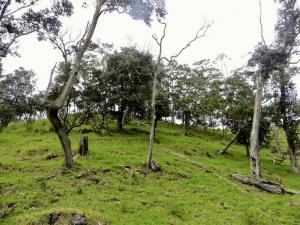Bringing multiple values to the table in Hawai`i land-use decisions
University of Hawaiʻi at MānoaLandowners across the state face decisions about the future of pasturelands, including the right mix of continued pasture, forest restoration and other land-use options like coffee or restoring to agroforestry (a once prominent land use in the region).
A growing body of research is being developed on the ways that land-use choices influence societal well-being. Huge strides have been made to quantify and include multiple values of land into decision-making. Yet, much of this research remains siloed among those that focus solely on the biophysical aspects, monetary value or broader social and cultural values. This division precludes different types of values being considered simultaneously by decision-makers in a meaningful way.
Over the past four years a National Science Foundation Coastal Science, Engineering and Education for Sustainability (NSF Coastal SEES) project, led by Tamara Ticktin of the University of Hawaiʻi at Mānoa botany department, gathered a transdisciplinary team of researchers across the University of Hawaiʻi, including UH Economic Research Organization (UHERO), geography, natural resources and environmental management (NREM), marine biology and elsewhere who have worked closely with conservation organizations, landowners and communities in Hawaiʻi to bridge this divide.
A recent article, “Bringing multiple values to the table: an assessment of future land-use and climate change in North Kona, Hawaiʻi,” published in the Journal Ecology and Society, describes a collaborative approach to assessing the multiple values that different ecosystems in Hawaiʻi provide and how collaboration with stakeholders, in this case Kamehameha Schools and the Kaʻūpūlehu community, can help evaluate and compare the potential future uses of pastureland.
Seeing natural regeneration of endemic dry forest plants is rare in Hawaiʻi, but keiki plants are plentiful in the Kaʻūpūlehu dry forest restoration project in North Kona on Hawaiʻi Island, a successful community-based effort to restore one of the most threatened ecosystems in the world. Many of the community members who work there are from cattle ranching families. They see tremendous value in mixed-use landscapes including native forest and pasturelands, but worry about encroaching urban development.
The paper was led by Leah Bremer of UHERO and the Water Resources Research Center, Lisa Mandle of the Natural Capital Project at Stanford University, Clay Trauernicht and Puaʻala Pascua of NREM, Kimberly Burnett and Christopher Wada of UHERO, Tamara Ticktin, Shimona Quazi, Natalie Kurashima and Heather McMillen in botany, and Thomas Giambelluca of geography. It was published as part of a special issue on ecosystem services, land use and climate change.
For more information, visit: https://www.ecologyandsociety.org/vol23/iss1/art33/


